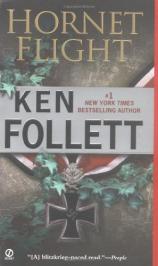Interview: December 6, 2002
December 6, 2002
Known for his thrillers (EYE OF THE NEEDLE, JACKDAWS, THE THIRD TWIN) and historical fiction (THE PILLARS OF THE EARTH), Ken Follett has entertained readers for decades. In this interview with Bookreporter.com Follett discusses the historical background behind his latest book, HORNET FLIGHT, and why he believes World War II fiction will remain popular.
Bookreporter: A major "character" in your book is a small plane, the Hornet Moth. You are either an aviator, repair engines as a hobby or are a great researcher. Which is it?
Ken Follett: Research. I spent time with a specialist in Hornet Moth engineering, Mark Miller, and went up in his plane. He also acted as consultant on the book, and corrected both first and second drafts. I also had flying lessons in a similar plane, a Tiger Moth.
BRC: In this book, you give great descriptions of tiny towns on small islands in Denmark. Are they fictional --- or do you travel for research purposes?
KF: The locations are either real or based on real places. "Sande" is Fano, and "Morlunde" is Esbjerg. I visited all the locations in Denmark and Sweden.
BRC: "Some of what follows really happened," you say, by way of prologue. Can you expand on that --- and tell us how you know the germ of this story?
KF: Two young Danish pilots who wanted to escape from German occupation found a Hornet Moth biplane in a barn. They repaired it and stole petrol from the Germans, then flew it across the North Sea to England. They brought with them movie film of the German radar base on the island of Fano. My story is inspired by what they did, although the details are different and all the characters are invented.
BRC: World War II ended 57 years ago. The men and women who fought it or remember it are dying off. And yet the World War II thriller survives. Why?
KF: It is the greatest drama in human history, the biggest war ever and a true battle of good and evil. I imagine that writers will continue to get stories from it, and readers will continue to love them, for many more years.
BRC: Reading your book the first time, I gobbled it up. The second time, I saw the expertise --- the sturdy construction, the plot twists, the character traits that determine what characters do. How much of the story of "Hornet Moth" did you "know" before you started writing? Did anything change as you wrote?
KF: Everything is planned. I spent a long time outlining. It's the only way I know to get all the ducks in a row.
BRC: What's the most fun writing these books --- the research, the plotting, the writing --- or typing THE END? Why?
KF: The research is the easiest. The outline is the most fun because you can do anything. The first draft is the hardest, because every word of the outline has to be fleshed out. The rewrite is very satisfying, because I feel that everything I do is making the book a little better. When I've finished, I enjoy the feeling that I've paid the rent for a couple more years.
BRC: In World War I and World War II in England, the government made great use of writers and other bright minds as spies and Intelligence officers. If you were asked to help in the war against terrorism.....
KF: Too unlikely to contemplate.
BRC: With all the cloak-and-dagger activity in the world today, should we expect your next book to be set in 2003?
KF: I'm working on a story set in 1948.
BRC: Do you ever frighten yourself?
KF: No. Remember, I know how it's done.
BRC: What suspense writers do you read with pleasure? Or do you avoid them and read only in other genres?
KF: Stephen King, Thomas Harris.
BRC: What's next for Ken Follett?
KF: My book after next will be a sequel to THE PILLARS OF THE EARTH.




